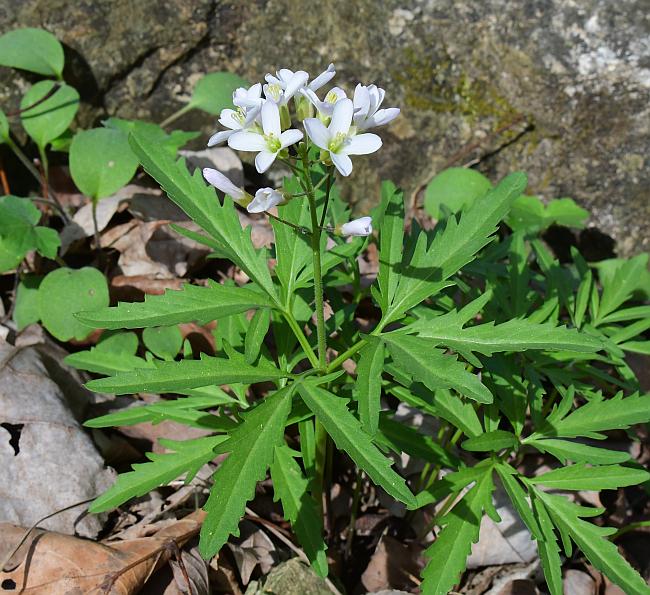Cardamine concatenata (Michx.) O. Schwarz
Cut Leaved Toothwort

Native
CC = 4
CW = 3
MOC = 76
© SRTurner
Cardamine concatenata (Michx.) O. SchwarzCut Leaved Toothwort | |
 |
Native CC = 4 CW = 3 MOC = 76 |
© SRTurner |
|
Family - Brassicaceae Habit - Perennial forb with elongate rhizomes consisting of thickened, beadlike, tuberous portions connected by thinner, threadlike portions. Stems - Weakly ascending to erect, to 40 cm, glabrous at base, pubescent with spreading hairs in upper portions. Leaves - Basal leaves usually absent on flowering plants, 13-30 cm long, long-petiolate, the blades trifoliate, the central leaflet sometimes divided or lobed into 3 divisions, the lateral leaflets sometimes unevenly 2-lobed; the leaflets 2.5-10.0 cm long, linear to oblanceolate or lanceolate, glabrous or sometimes with minute, spreading, marginal hairs, the margins sharply and usually coarsely toothed to irregularly incised, rarely nearly entire. Stem leaves 2-3 per stem in a single whorl or alternate, 3-5 palmately lobed, 4-12 cm long, short-petiolate, the lobes linear to oblanceolate or lanceolate, glabrous or sometimes with minute, spreading, marginal hairs, the margins sharply and usually coarsely toothed to irregularly incised, rarely nearly entire. Teeth of lobes mucronate (minutely). Petioles glabrous to pubescent.
Inflorescence - Terminal raceme, compact early but quickly elongating, the axis pubescent. Flower pedicels 1 cm, elongated in fruit, pubescent to glabrous.
Flowers - Sepals 4, 5-10 mm long, oblong, green, sometimes pinkish-tinged, the margins usually pale, glabrous. Petals 4, 10-20 mm long, white to light pink, glabrous, rounded at apex. Stamens 6, filaments 8 mm long, anthers yellow. Style erect, 5-8 mm long. Ovary terete, longer than broad. Stigma globose.
Fruits - Siliques 20-40 mm long, terete, glabrous. Seeds 1.9-2.7 mm long, broadly oblong to ovate in outline, the surface with a reticulate pattern of ridges and pits, orange to greenish orange.
Flowering - March - May. Habitat - Low woods, slopes, ravines. Origin - Native to the U.S. Lookalikes - None close. Flowers are similar to Cardamine bulbosa but the leaves are completely different. Other info. - This familiar member of the springtime flora is common across Missouri and throughout the eastern half of the continental U.S. It is absent in western states. It is easy to recognize by its large, 4-petaled white flowers and deeply lobed leaves with toothed leaflets. The flowers are larger than those of most other species in the genus. Photographs taken at Rock Hill Park, Boone County, MO., and at Eagle Bluffs Conservation Area, Boone County, MO., 3-27-04 (DETenaglia); also at Washington State Park, Washington County, MO, 4-8-2011, Silver Mines Recreation Area, Madison County, MO, 3-19-2012, and Young Conservation Area, Jefferson County, MO, 5-7-2018, the Ruth and Paul Henning Conservation Area, Taney County, MO, 4-5-2019, and near Labadie, Franklin County, MO, 4-5-2021 (SRTurner). |